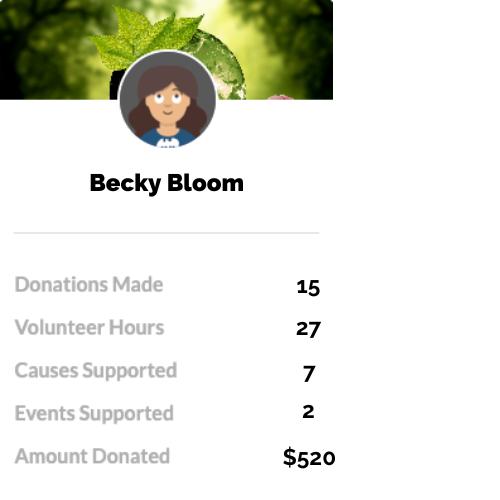- Is your company committed to social change but not sure how to track the results of your actions?
- Are you an active supporter in the community but aren’t aware of how much you contributed over the years?
- Do you want to share the results of your nonprofit’s community involvement but don’t know what metrics to report on?
In these scenarios, nonprofits, individuals, and companies’ social impact—the outcomes social good efforts have on the community—isn’t well understood. To understand social impact, one must:
- Track– Identify the right metrics to gauge success.
- Report– Communicate your findings in the appropriate format.
- Improve– Work towards becoming an even greater community contributor.
Why are social impact metrics important?
Before diving into this three-step framework, let’s discuss why social impact metrics are worthwhile to focus on:
Observable
Individuals and organizations can look back over a period of weeks, months, and years to evaluate the progress they have made over time with social impact metrics.
Credible
Many companies want to make a difference in their communities, while numerous individuals wish to take action and become a catalyst for change. Social impact metrics are authentic, adding credence to these ambitious goals and endeavours.
Simple
With each metric tied to an initiative, individuals (i.e., your customers, colleagues, and investors) reviewing your social impact will be able to understand how much of a difference you have made in a specific area.
Informative
Social impact metrics are measurable indicators of progress, allowing businesses and individuals to gauge what is working and where improvements can be made when it comes to giving back.
Tracking social impact
The first step to understanding social impact is measuring the results of your social good efforts. As an individual supporter, company, or nonprofit, stating you are committed to bettering the community through regular volunteering, donating annually, or organizing local fundraisers is the first step. However, do you know what criteria to track in order to assess the significance of your contributions?
Below are some key metrics to track that will help you understand how your social good actions are making a valuable contribution to society:
- Individuals: Number of donations made, amount of volunteer hours, causes supported, events supported, and amount donated.
- Companies: Amount raised globally, volunteer hours invested, causes supported, and members (employees) involved.
- Nonprofits: Number of fundraisers executed, number of volunteer days hosted, and amount received through donations.

Reporting on social impact
After you have gathered several key metrics to measure your social impact (whether you are an organization, individual, or nonprofit), the next step is reporting on these metrics. Reporting refers to taking the metrics you have just measured and communicating them to your stakeholders in a concise manner.
It is not until you report on your social impact that you can fully grasp the true difference your actions are making. Sometimes, all it takes is telling your story to others to help you realize all that you have done.
Reporting on social impact doesn’t always have to come in the form of detailed reports. Below are a few different ways to share your social impact with others:
Social Impact Platform

A social impact platform enables companies to demonstrate their commitment to social change and report their contributions along the way. With everyone donation made, volunteer hour contributed, and cause supported (by a company and its employees)—a social impact platform gathers these inputs and synthesizes them into real-time, simplified metrics that can be shared with the world.
PowerPoint presentations
A PowerPoint presentation is one of the simplest—yet still effective—ways to deliver a report on your organization’s social impact.
Before your next team meeting, create a PowerPoint that highlights your company’s social impact results over the last month, quarter, or year. The most effective way to do this would be to keep a running total of your company’s social impact as it builds (i.e., how much they donated or how many hours they volunteered) and then share these numbers in a master presentation.
Be sure to include a bit of background information regarding the social good initiatives you initially set out to do and the progress you have made towards meeting these initiatives. If you fell short of meeting any social impact goals you may have set, explain the steps you plan to take moving forward to make improvements.
Social media
Social media is one of the most powerful tools to utilize to share your social impact. If your nonprofit has a Facebook page, be sure to regularly communicate with your group members about how much your nonprofit has raised to date or the number of volunteers currently supporting your cause.
Social media is also a powerhouse for individuals since so much of what people do is shared online. Why not diversify your followers’ Instagram feeds with a post sharing how much you recently donated to a particular nonprofit? You never know; it might inspire at least one person to follow in your footsteps and donate.
Email newsletters
Email newsletters are an essential method to communicate information and share updates on a regular basis. In your next monthly email newsletter, share with your employees, customers, and community supporters the progress your company or nonprofit has been making toward impacting the community.
Email templates are customizable to your needs; therefore, you can report your social impact metrics through unique infographics or charts. Powerful visuals will not only make your social impact look nicer, but visuals increase the desire to read content by 80%.
Improving social impact
Tracking and reporting on your social impact will allow you to understand how your efforts make a difference in your community.
However, if you constantly strive to improve your social good initiatives, you will understand that social impact is always a work in progress. The more you can improve—in terms of increasing the hours spent volunteering, fundraisers hosted, or money donated— the better the results, leading to a greater social impact than before.
The following are some specific areas you can implement, as an individual, nonprofit, or organization, to improve social impact:
Encourage volunteerism as an organization
If your goal is to encourage more employees to volunteer for a specific cause, consider offering a designated amount of paid volunteer days to your employees. Beyond just adding these days to an employee contract, make a conscious effort to share the volunteer experiences of other employees to encourage others.
Connect with local opportunities as a community supporter
It might be difficult as an individual to find the proper online resources that will help connect you with a diverse range of volunteer opportunities in your community. Create a fun challenge for yourself, finding one new opportunity each month through an online forum.
Additionally, reach out to friends, colleagues, or peers to see if they might know of any upcoming opportunities to participate locally.
Consider unique fundraiser ideas as a nonprofit
As a nonprofit, you might have already hosted one too many virtual runs or online auctions, and you are left saying, “Now what?” Collaborate with your colleagues or volunteers to bounce creative ideas off each other when hosting your next fundraiser.
Now that in-person events are starting to pick back up, think of some creative fundraiser ideas that haven’t been done yet. For example, instead of a BBQ, why not turn that into a western-themed evening with games and prizes to be won?
Take the steps to understand your social impact
Kambeo is a corporate giving platform to help individuals, nonprofits, and businesses understand their social impact.
Track your social impact by monitoring key metrics, report on your progress, and continually improve your social impact by connecting with others who all want to make change happen.



